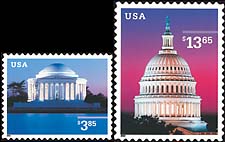
The two new releases, along with the $3.50 Capitol Dome and $12.25 Washington Monument stamps of 2001, mark a noticeable departure from the Space Shuttle stamps that were issued during 1995-98 for various Priority Mail and Express Mail rates. Perhaps these four stamps mark the beginning of a series of high-value stamps depicting Washington, D.C., landmarks.
The U.S. Capitol building is part of the design of numerous previously issued U.S. stamps. On Sept. 18, 1793, President George Washington laid the cornerstone of the Capitol, located in the building's southeast corner. The original building was designed by Scottish physician William Thornton. His plan called for a building made up of three sections. The central section, topped by a low dome, was to be flanked by two rectangular wings (one for the Senate and one for the House of Representatives) on the north and south. Construction proceeded with fits and starts for the better part of 20 years. During the War of 1812, the Capitol was significantly damaged by a fire set by British troops. If not for a sudden rainstorm, the building would have been completely destroyed. Architects Benjamin Henry Latrobe and Charles Bullfinch directed the restoration effort during 1815-19. Bullfinch replaced the original dome with a larger, copper-covered wooden dome. He completed the last part of the building in 1826. During 1830-68, the Capitol grew even more to accommodate the increasing numbers of senators and representatives from states newly admitted to the Union. As the building expanded, it became apparent that Bullfinch's dome was no longer proportional with the rest of the structure. Architect Thomas U. Walter designed a larger fire-proof dome of cast iron that Congress approved in 1855. Walter's dome is the one shown on the Capitol Dome stamp. This massive dome, weighing nearly 9,000,000 pounds, was hoisted atop the Capitol using steam-powered derricks. Sitting atop the dome is Freedom, the statue designed by Thomas Crawford and cast in bronze by Clark Mills. Weighing in at nearly 15,000 pounds and standing 19 feet tall, Freedom was married to the dome in 1863.
The Jefferson Memorial was dedicated April 13, 1943, 200 years to the
day after Jefferson was born. The memorial is a fitting tribute to
the man who authored the Declaration of Independence, served as the nation's
third president and founded the University of Virginia. Planning for the
memorial began in 1934, when Congress established the Thomas Jefferson
Memorial Commission. Architect John Russell Pope sought to preserve Jefferson's
passion for Neoclassical architecture in the design of the memorial. Pope
decided to base his design on the Pantheon in Rome. Ironically, the Commission
of Fine Arts looked with disfavor on the Pantheon-based design, feeling
that it would compete with the Lincoln Memorial. President Franklin
D. Roosevelt liked Pope's design and gave permission to begin formal construction.
Roosevelt laid the cornerstone in a ceremony held Nov. 15, 1939. The memorial
was dedicated in 1943. In 1941, sculptor Rudolph Evans was commissioned
to produce the statue of Jefferson that gazes from the interior of the
memorial toward the White House. The massive 19-foot bronze portrait statue
weighs 5 tons and stands atop a 6-foot pedestal. A plaster model
of the statue was in place during World War II because of restrictions
on the use of metals. After the war, the restrictions were lifted and the
bronze statue was placed in the memorial. The plaster model resides in
the memorial's basement, too large to be removed intact. Panels on the
interior walls bear excerpts of Jefferson's writings. One of these quotes
captures perfectly the essence of Jefferson's greatness: "I have sworn
upon the altar of God eternal hostility against every form of tyranny over
the mind of man."
|
|
|
| Date of Issue | July 30, 2002; Washington, D.C. |
| Photographer | Robert Shafer, La Quinta, Calif. |
| Designer, Art Director and Typographer | Derry Noyes, Washington, D.C. |
| Modeler | Banknote Corporation of America, Browns Summit, N.C. |
| Printing Process | offset (hidden image: U.S. flag in upper-right corner) |
| Contractor, Printer and Processor | Banknote Corporation of America, Browns Summit, N.C. |
| Press | Goebel 670 |
| Colors | cyan, magenta, yellow, black |
| Paper | prephosphored type II |
| Gum | self-adhesive |
| Format | pane of 20 |
| Size | 1.09 inches by 1.42 inches (image);
1.23 inches by 1.56 inches (overall); 7.13 inches by 7.26 inches (pane) |
| Print Quantity | 35 million stamps |
| Plate Numbers | "B" followed by four single digits |
| Marginal Markings | "2002 USPS," plate numbers, pane position diagram; bar code on front of pane and on back of pane, price |
|
|
|
| Date of Issue | July 30, 2002; Washington, D.C. |
| Photographer | Carol Highsmith, Tacoma Park, Md. |
| Designer, Art Director and Typographer | Derry Noyes, Washington, D.C. |
| Modeler | Banknote Corporation of America, Browns Summit, N.C. |
| Printing Process | offset (hidden image: Thomas Jefferson's signature in lower-left corner) |
| Contractor, Printer and Processor | Banknote Corporation of America, Browns Summit, N.C. |
| Press | Goebel 670 |
| Colors | cyan, magenta, yellow, black |
| Paper | prephosphored type II |
| Gum | self-adhesive |
| Format | pane of 20 |
| Size | 1.42 inches by 1.09 inches (image);
1.56 inches by 1.23 inches (overall); 7.26 inches by 7.13 inches (pane) |
| Print Quantity | 100 million stamps |
| Plate Numbers | "B" followed by four single digits |
| Marginal Markings | "2002 USPS," plate numbers, pane position diagram; bar code on front of pane and on back of pane, price |